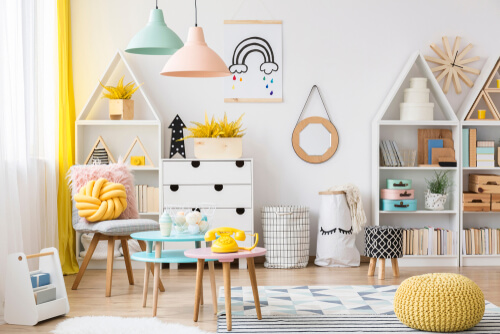
Parents of young children, toy storage sounds deceptively simple at first, doesn’t it? “Need someplace for toy storage? A playroom takes care of that.” Much to our dismay, playrooms often become permanent whirlwinds of chaos, with small plastic toys littering the floor and books piled high in the corners. Unless we as parents are committed to keeping the playroom tidy ourselves, we usually feel resigned to living with this mess. If you need help, this post all about “toy storage: playrooms” is a must read!
The good news is, a properly organized playroom is a joy for children to help clean. Children can be trained to enjoy the same sense of satisfaction and well-being we all experience when our spaces are tidy and ready to use, but first they must have access to storage solutions that are easy for small hands to reach and young minds to understand.
Re-imagining the Playroom Closet
Often playrooms have familiar wall closets with sliding doors that we have all agreed we dislike. While a traditional hanging rod is nearly useless in a playroom, a wall closet is anything but. Once the closet doors have been removed, the recessed area can be divided horizontally, creating space for a small reading or napping loft for your child above. The space below can be divided vertically; a small hanging rod on one side could be useful for a child who enjoys dress-up or uses art smocks frequently, while a quad shelf on the other can be stocked with fabric bins that can store loose toys. Without sacrificing any floor space, you’ll have gained three new zones for your playroom.
Built-In Bookshelves—But No Books, Please
We adults may love a bookshelf crammed with beloved titles, but small children have difficulty placing books into traditional shelves. If your playroom is also the reading area, consider forward-facing gutter or frame-style book displays that hold fewer books toward the child. You will probably want to rotate these books frequently to entice curious minds, so don’t worry about having too few books displayed.
Bookcases do shine as a storage solution for toys, however. While the type of storage your playroom needs will vary depending on your child’s interests, it will need to be easy for your child to use and understand. While we adults may like the idea of 12 identical sage-green boxes, your child might be confused by the bland sea of box fronts. Clear-front drawers with proper labels and a photograph or drawing of the type of item that belongs in each box can make cleanup a breeze, so you may want to balance your aesthetic preferences against ease of use.
Remember: small children have difficulty placing books into traditional shelves.
Incorporate Storage into the Play Structures
If you look at your child’s toys by category and interest, you’ll probably see a theme emerging. Whether your child’s play kitchen is constantly overflowing with beloved play food and dishes or their engineering blocks are scattered about hazardously, there is most likely a type of toy that presents your greatest organizational challenge.
This insight can be the foundation to your playroom’s theme. The young chef might love a playroom that has a designated café or market, while the young engineer would prefer a large building table surrounded by built-in drawers to house their materials. In either case, choosing play structures that organically function as storage will help encourage your child to see tidying as an act that naturally accompanies play and fun itself.
Always organize your children’s toys by category and interest, keeping the child in mind.
Embrace Toy Rotation
While we all want our children to have access to a wide variety of toys, research has indicated that children have more fun when there are fewer toys presented at once. When you evaluate your options for storage creation, it’s key to remember that you only need to keep a percentage of toys available at any given time. Bringing old favorites out after a few months away often serves to enhance a child’s enjoyment of them, and inclusion of seasonal toys can help small children understand the year’s rhythms.
By choosing to focus on a fewer number of high-quality storage and display options over towers of cheap plastic boxes filled with random jumbles, you can help your child establish patterns of mindfulness and appreciation for beloved possessions.


